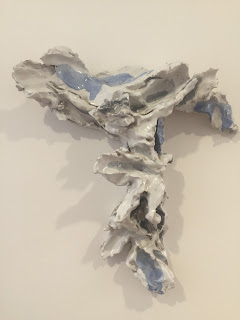In yet another stunning exhibition at Karsten Greve’s corner gallery in the Marais, Lucio Fontana’s ceramic Crosses are strangely sublime. In keeping with my commitment to a modernist aesthetic, I have always been more interested in Fontana’s renowned defacement of the painted canvas than his ceramics. However, at the 2014 exhibition at the Musée d’Art Moderne de la Ville de Paris I realized that painting was more than it appeared thanks to the emphasis on the three dimensionality of the “cut canvases.” Even though the ceramic crosses appear very different from the cut canvases, this dimensionality and spatial articulation is clearly consistent between the two forms.

Here at the Karsten Greve exhibition, I discovered a delicate desecration of a different kind. The ceramics of Christ on the cross, in some cases Christ without a cross, and in others, crosses without Christ are beautiful and, of course, because they represent the sacrificial, they are painful. The contorted body of Christ is, like the misshapen cross with which he merges, hand moulded and fired such that the two verge into abstract form and emotional expression. The coming together of these two incompatible modes makes the pieces unusual and simultaneously exciting.

The surface of each piece is sumptuous, and the colour is
surprising; where green turns into gold which turns into red and blue, the
forms become ethereal, like fabric blowing in the wind rather than handmade
ceramic sculptures. The materiality of the pieces is smooth so that it’s difficult to
resist the temptation to run our fingers across the smooth, delicate surface, to
feel this complex object that leaves behind a shadow as it seems to fly off the
wall. We can see and want to trace the curves left by Fontana as he has moulded
the clay, and left the edges as if suspended in midair. We can feel the indentations left by his fingers, the piece of clay stretched out to become a
hand begging for mercy, a torso writhing in pain, a head bowed exhaustion. Even
though the form is abstract, we have no difficulty finding the body and
emotions of Christ.
One of the most curious aspects of the ceramic sculptures is
their size; on the clean white walls of the gallery they appeared tiny. Their
size makes them delicate, and somehow contributes to the pain as the expression
given to the murdered Christ. As I walked around, I wondered if they could be religious?
They are, after all, crucifixions. But, I am not sure they are any more sacred
than Pasolini’s The Gospel According to
Saint Matthew (1964), a film more interested in the social and ideological
ramifications of power and sacrifice than it is in the biblical story. However, unlike Pasolini, Fontana doesn’t
seem to be criticizing the church and its want to hang people on crosses.
Rather, it’s as though Fontana uses the subject matter of the bible and its
history as a vehicle for his concern with the use of art and colour to express
the inexpressible. These fine works are perhaps best understood as artistic expressions of
extreme emotion.





No comments:
Post a Comment